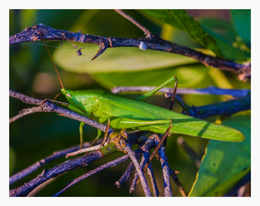Wildlife Tidbits
Identifying Characteristics
— Medium to large (24-74 mm) grasshopper-like
— Head produced into a pointed or rounded cone
— Can be green or brown
— Cone is separated from face by a gap
— Cone does not have a sharp point
Habitat Characteristics
— Most often found on the plants that they eat
— Common in grasses and marshes
— They sometimes use cornfields
— Reproduce in crowns of grass clumps
Fun Facts
— Conehead katydids are also known as long-horned grasshoppers due to their long, slim shape.
— Katydid nymphs look like adults but they lack wings. As they grow the nymphs shed their exoskeletons
several times, finally getting wings during their final molt.
— Although some katydids can take to the air, they are generally known as poor fliers.
— Female katydids are typically larger than males.
— Their relatively long hind legs are used for jumping.
— Males will climb onto plants and rub their front wings together to "sing" at night to attract females.
— The katydid's common name is said to be derived from the call that some make, that sounds a lot like
"Katy Did, Katy Didn't, Katy Did, Katy Didn't, Katy Did, Katy Didn't..." But not all species make this sound.
— Katydids, like many insects, avoid being eaten by being mostly nocturnal. Their coloring, that blends in
with the plants they feed on, helps to conceal them too.
— Bats, that listen for the katydid's "love song," are one of their main predators.
— Katydids are solitary critters and finding one doesn't mean there are others around.
— Although they aren't usually found in groups, katydid's can sometimes be crop pests.
— Katydids may bite when handled.
Taxonomy
— Insects are in the class "Insecta"
— The Conehead Katydid is in the katydid family "Tettigoniidae"
— It's genus is "Neoconocephalus"
— Species in the genus are considered "Common Coneheads"

More Information